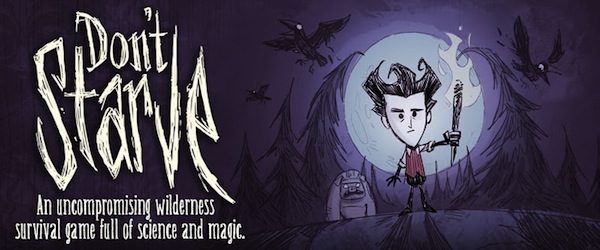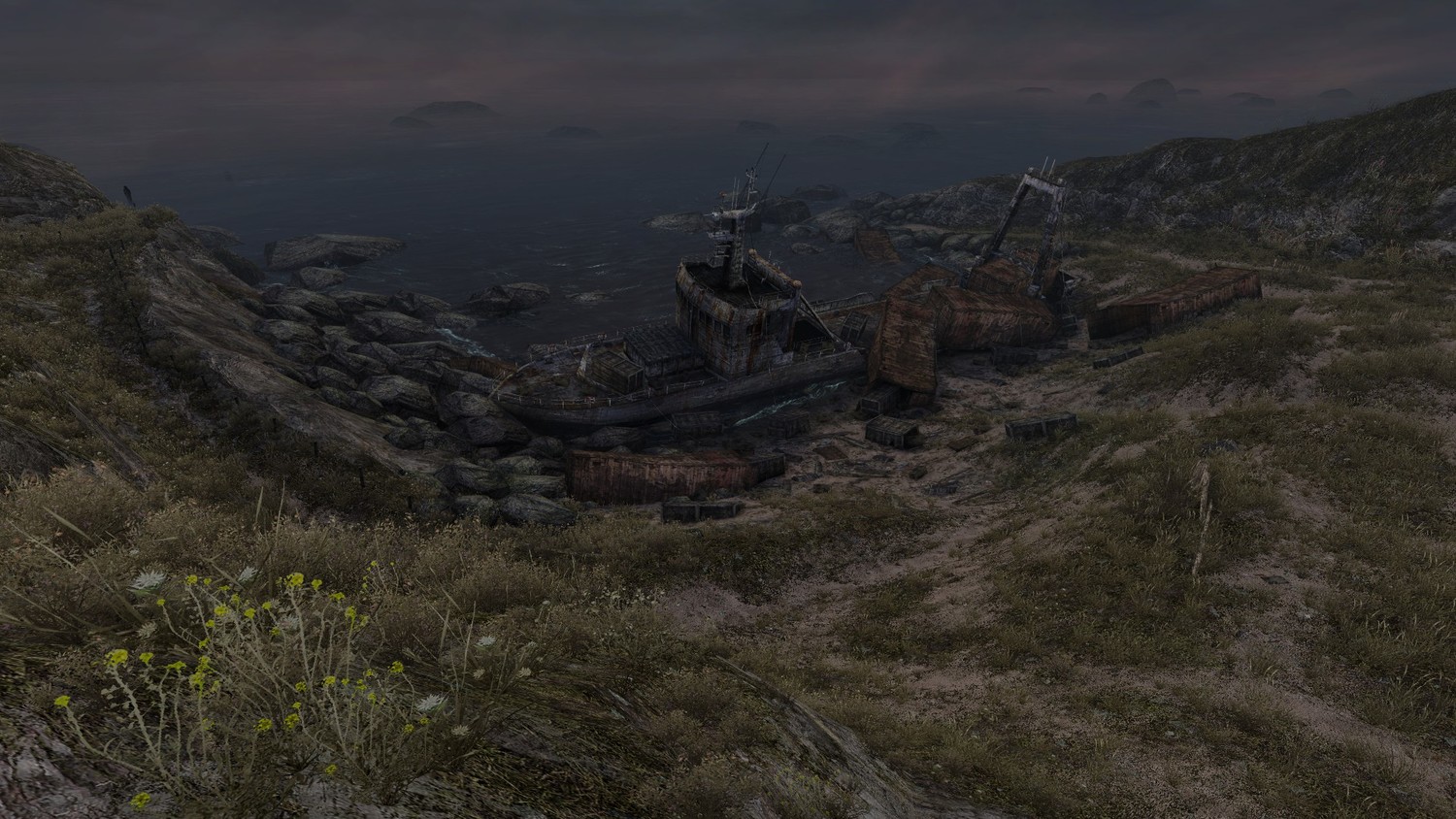
Review: Don’t Starve (Console Edition)
Posted by Eric G on February 13th, 2014 | 0 Comments | Tags: Don't Starve
Pre-reading – The Run-Arounder
A genre of video games composed of three crucial attributes: Running around (this can be done in first-person, third-person, or an isometric view); gathering resources; and, perhaps most importantly, a lack of a definitive objective or end goal. Run-Arounders such as Minecraft and Terraria have been miscategorized as survival or sandbox games. For more information about Run-Arounders, consult the Run-Arounder conception episode of PSNStores Podcast. And now, without further ado, the main attraction, the moment you’ve been waiting for, what you truly came here to read, the review for Don’t Starve.
The Review
Don’t Starve is a Run-Arounder that released on Steam a good while back. The game recently made its console debut on the PlayStation 4 as a free offering for PS+ subscribers. I’ve been playing it on and off since its release, with feelings wavering from confusion to delight to frustration to despair. The prevailing emotion I get from playing Don’t Starve is a mix of vulnerability and desperation, which is the game’s strongest attribute. The sound design plays a pivotal role in this matter, as does the gameplay and the graphics. The only hiccup in the game is its user interface, which was designed for and probably best used on a PC.
 Run-Arounders have been quite prevalent in the last few years. After the mammoth success of Minecraft, it seems nearly one in every three games has incorporated some sort of crafting mechanic. It’s the experience points/level-up system of a few years ago, jammed into every game to create a sense of depth or progression. Don’t Starve‘s crafting system doesn’t innovate much. You start with nothing but your mitts, and you’re surrounded by a relatively expansive procedurally generated world. A man in black prompts you to get some food before it gets dark, and you’re off. The first few things you can gather – flint and sapling twigs – lead to the ability to make an axe, which grants you the ability to chop down trees and gather logs, which, combined with cut grass, creates a campfire. I think you get the progression. Small, basic materials are used to create more intricate, more valuable items. I use the term ‘value’ not because you can sell anything in this game. No, the value in Don’t Starve is derived from an item’s ability to keep you alive. Food plays a large role in this endeavor.
Run-Arounders have been quite prevalent in the last few years. After the mammoth success of Minecraft, it seems nearly one in every three games has incorporated some sort of crafting mechanic. It’s the experience points/level-up system of a few years ago, jammed into every game to create a sense of depth or progression. Don’t Starve‘s crafting system doesn’t innovate much. You start with nothing but your mitts, and you’re surrounded by a relatively expansive procedurally generated world. A man in black prompts you to get some food before it gets dark, and you’re off. The first few things you can gather – flint and sapling twigs – lead to the ability to make an axe, which grants you the ability to chop down trees and gather logs, which, combined with cut grass, creates a campfire. I think you get the progression. Small, basic materials are used to create more intricate, more valuable items. I use the term ‘value’ not because you can sell anything in this game. No, the value in Don’t Starve is derived from an item’s ability to keep you alive. Food plays a large role in this endeavor.
I should make note of the game’s losing condition – death – and what leads to it. First of all, there’s a day-night cycle that occurs, indicated by a timer in the top-right corner of the screen. When night falls, unless you’re near a light source, you’re dead. Your character has three major attributes: Health, which can be replenished by eating; Hunger, which depletes over time if you’re not eating; and Sanity, which can be replenished by maintaining a full hunger level or hanging out near a campfire. The most important meter, the one you will constantly be triple-checking, is hunger. Having a low hunger meter will negatively affect the other two attributes over time. Luckily, food can be obtained a multitude of ways. The most basic way to eat is to pick berries, carrots, or flowers. The next step up would probably be creating a trap to catch rabbits. Caught bunnies can be murdered then cooked by a fire to create morsels. Seeds, eggplant, and other items can also be cooked. It’s not easy to keep your hunger level at a safe level, something that accurately parallels the feeling of being lost in the wild. I wouldn’t know first hand, of course, as I’m personally not a fan of camping. When I have been dragged into the woods with friends, we always pack dogs, beans, cold ones, and other snacks to sustain us. But back to the vidcon.
 Another of Don’t Starve‘s successes is in the creation of a unique, darkly fantastic world. The graphics and sound design help immensely in this effort. What you’ll inevitably notice upon booting up Don’t Starve is that the characters and environments are displayed as 2D paper-craft creations, complete with scribble marks as shading. Then, when the man in black ‘speaks’ to you and when you interact with objects, you’ll hear not voices but musical instruments. I was put off at first, but it didn’t take long for me to appreciate this new take on voice acting. Wilson, the gentleman scientist and first available character, speaks in trumpet notes. Other characters are voiced by a flute, a clarinet, a tuba, and more. In addition to the bizarre voicing, the background music is deliberately weird. During the day time, you won’t hear much music. The only sounds include animal noises (chirping birds, shuffling rabbits, etc.) and character noises (tree chopping, resource gathering, etc.). When dusk hits, a devious riff plays to signify that the potentially fatal night is not far off. As is the case in most scary works, the lack of music is a supplement to the experience as a whole.
Another of Don’t Starve‘s successes is in the creation of a unique, darkly fantastic world. The graphics and sound design help immensely in this effort. What you’ll inevitably notice upon booting up Don’t Starve is that the characters and environments are displayed as 2D paper-craft creations, complete with scribble marks as shading. Then, when the man in black ‘speaks’ to you and when you interact with objects, you’ll hear not voices but musical instruments. I was put off at first, but it didn’t take long for me to appreciate this new take on voice acting. Wilson, the gentleman scientist and first available character, speaks in trumpet notes. Other characters are voiced by a flute, a clarinet, a tuba, and more. In addition to the bizarre voicing, the background music is deliberately weird. During the day time, you won’t hear much music. The only sounds include animal noises (chirping birds, shuffling rabbits, etc.) and character noises (tree chopping, resource gathering, etc.). When dusk hits, a devious riff plays to signify that the potentially fatal night is not far off. As is the case in most scary works, the lack of music is a supplement to the experience as a whole.
The wacky world of Don’t Starve is made complete by the cast of creepy creatures that roam its lands. Long-legged cyclops creatures defend their eggs. Anthropomorphic pigs wander around their huts (or help you if you provide them with food). A walking chest with teeth offers you a place to store your items (though I did not trust it). Tentacles rise out of swamps and caves to lash at you as you walk by. Much of the fun to be had in the game is by discovering new places and beings, then interacting with (read: killing) them to see what happens. Although I’m not usually too keen on procedurally generated content, I think it works to great effect in Don’t Starve. The fact that each game drops you into a world with uncertain levels of resources forces you to adapt in order to survive. If you’re having trouble finding a field of boulders, you’re going to have to build campfires for a while. If you don’t seem to come across Beefalo manure, you may want to reconsider farming as a food source. For those low on patience, the game also features a Default Plus mode, which starts you off with a ton of items in a harsher world. If you absolutely hate being tied down by presets, you can edit 31 different slider options to create your own playground.
In all, Don’t Starve is an interesting game because it doesn’t necessarily provide a ‘fun’ experience. That being said, I think it’s great in large part because of its uncompromising nature. It’s aptly named, meaning you will constantly be on the defensive to fill your belly and keep your sanity. The graphics are quirky, and the sound design fits nicely. You can tell the game’s UI was developed for PC. After a couple of plays, inventory management becomes easier, but it always felt clunky in some capacity. An added incentive to replaying the game comes in the form of unlocking characters. After you perish, experience points go towards unlocking the next of eight available characters. Each character has his/her own strengths and weaknesses, sometimes in the form of a useful item (Willow’s lighter, for example, can light things on fire). I’m no pro at the game (in around a dozen hours I’ve unlocked three characters and made it to day 9), but there is a ton of opportunity for crafty players with a will to survive.
A copy of this game was purchased for free as a PlayStation Plus benefit for review purposes. For more info on our review policy click here.
General Info
- Platforms: PS4 (Reviewed)
- Release Date: January 2014
- Price: $14.99, (Free with Plus), £11.99/€13.99
- Genre: Resource Management, Run-Arounder, Survival
Score:
What I Like:
- Feeling of vulnerability
- Feeling of discovery
- "Default Plus" Mode
- Remote Play ease
What I Dislike:
- Ruthless difficulty spikes
- The dark




